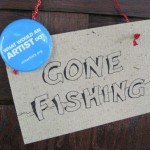How is going fishing good for creative entrepreneurs? Brain research now shows that downtime activities support creativity.
You know that, right? Get stuck on a project, and you might take a walk to clear your mind. Set out in a boat on a quiet lake, even better.
The added bonus for your creativity is if your incubation time includes something new to you. Exploring outside your field, in a realm unrelated to your usual focus adds to the raw materials and interconnections you have for making something novel and useful.
For me, fishing would fit the bill. I don’t fish, and never have. While that’s certainly lucky for the fish, playing with tackle, rod and reel to learn a new skill would be good for my creativity. Here’s why.
Three things you can do to support your creativity:
- Broaden your knowledge and skills. Read, take classes, hang out with diverse people, and learn about fields unrelated to your own.
- Spend time in nature. Allow your ideas to incubate.
- Seek out challenging tasks. Trying to figure out a project that doesn’t necessarily have a solution leads to new ideas
Do all three at once and triple the value of your downtime.
But what do creative people need with more creativity?
Running a creative business means knowing how to both generate ideas and develop them. We need to apply our creative prowess to the later stages when we polish and shape our ideas into reality.
Outlines of the creative process may always come up short. But about 70 years ago, James Webb Young presented a 5-stage creative process based on his own experience in the ad biz. His model for producing ideas, similar to that of English sociologist Graham Wallas (1926), still has relevance today.
Here’s my synopsis of Young’s model of idea development:
1. Gather it in – collect raw materials, knowledge, skills and experiences that are both specific to your field and unrelated.
2. Soak it up – take in what you’ve gathered, mess it around, tune in and get to know and understand it
3. Let it go – allow it all to incubate
4. Mull it over – bring it back into focus with renewed light and insight
5. Shape it up – make it fit the context of what your after and make it real
While this framework may be both linear and cyclical at the same time, new science gives clout to the incubation phase.
Recent studies in the field of neuropsychology lend support for the role of downtime. Scientists such as Dr. Rex Jung found evidence that brain activity actually down-regulates in the frontal lobe during creative tasks, and that certain techniques facilitate this “transient hypofrontality.” Meditating, taking a walk, enjoying a long bath or going fishing, for example, take the brakes off the front part of the brain and let the ideas flow more freely.
What activity would support your own creative process? Whether it is taking on the challenge of something new, expanding your knowledge base, or incubating your ideas out in nature, I hope you find your own version of “fishing” today.
Go fish!
(This article was written for a guest post on TheRightBrianBusinessPlan.com)
 Making way for creative action, Amy Egenberger, MEd., CPCC, is proud to be a Licensed Facilitator of the Right Brain Business Plan®. She is a seasoned educator, life coach, artist and founder of Spirit Out! Coaching. Amy helps people find the courage and clarity to get moving on their creative path. A book, a business, a project, a change… your creative spirit gets out! Amy is one of our licensed Right-Brain Business Plan® Facilitators.
Making way for creative action, Amy Egenberger, MEd., CPCC, is proud to be a Licensed Facilitator of the Right Brain Business Plan®. She is a seasoned educator, life coach, artist and founder of Spirit Out! Coaching. Amy helps people find the courage and clarity to get moving on their creative path. A book, a business, a project, a change… your creative spirit gets out! Amy is one of our licensed Right-Brain Business Plan® Facilitators.

